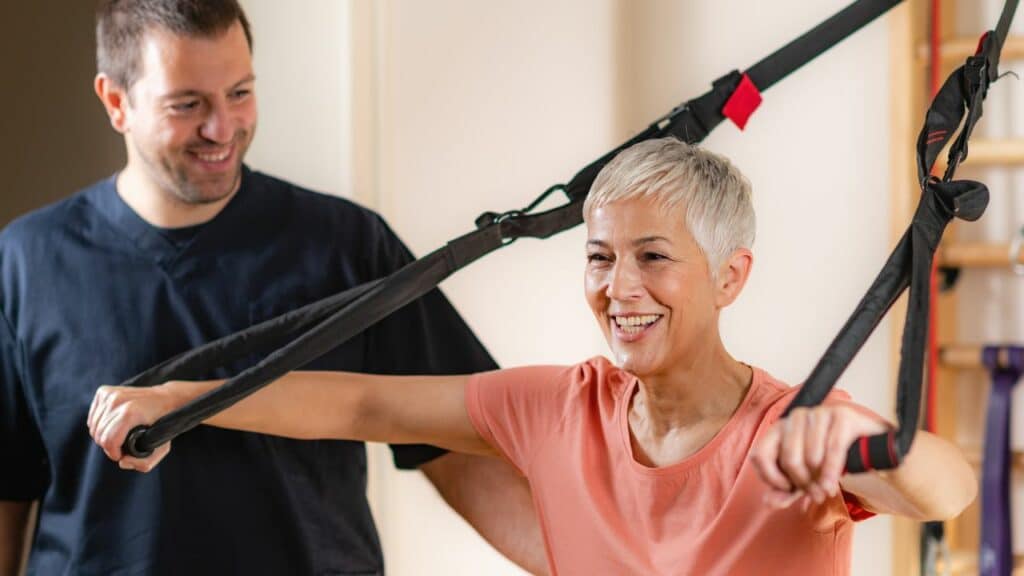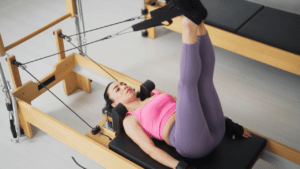
It’s never too late to start taking care of your physical health. As we age, functional training becomes increasingly important to maintain muscle strength, balance, and flexibility. This can reduce the risk of falls and injuries, and help seniors maintain an independent lifestyle. One safe and effective method for functional training is TRX, which uses suspension training to engage the core muscles and utilize body weight in various exercises. In this article, we will discuss the benefits of TRX training for seniors, safety precautions to consider, exercises suitable for beginners, and tips for integrating TRX into a weekly routine.
The Benefits of TRX for Seniors
TRX focuses on building functional fitness, which is key for seniors. While machines at the gym target individual muscles, the main benefit of TRX is that is works multiple muscle groups at once through dynamic exercises that mimic real-life movements. This trains your body to better handle everyday activities like getting up from a chair, climbing stairs, or carrying groceries. According to a study published in the International Journal of Exercise Sciences, suspension training was found to enhance functional fitness for seniors and provide a safe way to improve core strength and mobility.
Specific Benefits of TRX Training for Seniors
- Improved balance and stability: TRX exercises challenge your body’s balance and stability, which can help improve proprioception and decrease the risk of falls.
- Muscle strengthening: By using your own body weight in resistance training exercises, TRX targets various muscle groups, including the core, arms, back, and legs. This helps seniors maintain their independence and functional health.
- Manage lower back pain: Study have shown that TRX is good for lower back pain because it focuses on building strong, flexible muscles that act as a natural brace for the spine, helping to relieve pain. Weak muscles lead to increased spine pressure, which is a common cause of back discomfort.
- Enhanced joint flexibility: TRX exercises can aid in improving joint flexibility and range of motion, which can assist in daily activities such as reaching, bending, and turning.
- Bone health: Resistance training, like TRX, can also assist in combating osteoporosis by increasing bone mineral density.
- Cognitive health: TRX with its challenging, multi-step exercises, keeps your mind sharp. Physical activity has been linked to improved cognitive function and mental well-being.
- Enhanced cardiovascular health: TRX gets your heart pumping!
- Confidence: Performing routine physical activities will boost your confidence and give you a sense of accomplishment.
Safety Precautions for Seniors Using TRX
While extremely beneficial, it’s important for seniors to take precautions when starting TRX training. As a senior, it is important to adapt the TRX workouts to your current fitness level and any physical limitations you may have.
- Consult your physician before beginning any new exercise program. Make sure TRX is safe for your individual health status.
- Consider initial training sessions with an instructor familiar with TRX for seniors. They can teach proper form and technique.
- Find a buddy. Having a spotter makes it safer to try TRX exercises while also building confidence. They can help motivate you while keeping a close eye on form.
- Start slowly and adjust the body position to an appropriate difficulty level for your current fitness capability. Progress gradually over time.
- Listen to your body and don’t overexert yourself. Know when to take breaks and modify exercises if they cause discomfort.
TRX Workouts for Seniors
TRX is adaptable for seniors at all fitness levels, from beginners to more active. It uses your body weight as resistance, which can be adjusted by positioning yourself closer to or further from the anchors. Be sure to start slowly and focus on proper form. Also, consider if you might need a spotter the first few times and where you’d want to have them positioned for support.
Basic TRX Exercises to Get You Started
- TRX Squats – Stand facing anchors. Hold handles at sides with arms extended. Slowly bend knees and hips to lower body as if sitting in a chair. To get started, a spotter can stand behind you to help keep your balance.
- TRX Chest Press – Face away from anchors with feet hip-width apart. Lean body forward holding handles at chest level. Bend elbows slowly to lower body and then extend the arms to return to the start position.
- TRX Low Row – Face anchors with feet hip-width apart. Lean body back holding arms extended. Pull elbows in towards ribcage squeezing shoulder blades. Return to start slowly.
- TRX Bicep Curl – Face the anchors like you did for the low row with handles at sides. Keeping elbows by ribs, slowly curl handles up towards shoulders engaging biceps. Lower back down controlling movement. A spotter can provide light resistance at the wrists.
- TRX Tricep Extension – Face away from the anchors with arms extended in front of you at shoulder level with knuckles pointing up. For beginners, start by having one foot forward for support. Begin by bending your elbows and bringing your knuckles a few inches above your forehead. Extend arms fully upwards to return to start.
Sample Starter TRX workout
Shoot for 30 minutes in length for your workout. Don’t overlook a proper warm-up and cool-down to prepare muscles and increase flexibility.
- 5 minute warm-up: walk in place, knee raises, arm circles
- 3 sets of 8-10 reps of: squats, chest press, bicep curls, low rows
- 3 sets of 5 reps of: squats, tricep extension, bicep curl, chest press
- 5 minute cool down: calf stretch, child’s pose, neck rolls
Tips for Integrating TRX into a Seniors Weekly Routine
When introducing TRX suspensions exercises into your routine as a senior, it’s important to start slowly and focus on listening to your body. The key is finding a sustainable routine that allows you to benefit from TRX while avoiding injury or overexertion. With some simple guidelines, TRX can become a staple in maintaining functional fitness as you age. Let’s go over how to make TRX work for you.
- Aim to include TRX 2-3 times per week, with rest days in between. This allows your muscles adequate recovery time.
- Alternate between strength training with TRX and gentler cardiovascular exercise like walking or swimming on off days. This complements your workout with added mobility and calorie burning.
- Start with lighter TRX workouts focusing on proper form for the first 2 weeks. Then gradually increase intensity by changing body position, adding reps, and trying more advanced movements.
- Listen to your body and take a break or reduce activity if you feel pain or discomfort. It’s better to be safe than risk injury by overdoing it.
- Stay well hydrated before, during and after TRX sessions. Proper nutrition with adequate protein also helps muscles recover.
- Make sure to include rest days where you abstain from strenuous activity altogether. Muscles need time off to repair and strengthen.
Final Thoughts on TRX Training for Seniors
TRX suspension training is an extremely effective way for seniors to build and maintain functional fitness. It strengthens the entire body so you have the mobility, balance, and coordination needed for everyday life. TRX prevents costly injuries from falls while also providing cardiovascular, cognitive, and bone density benefits. With countless exercises to choose from and the ability to modify according to current fitness level, TRX offers an adaptable workout.
Starting TRX may seem intimidating at first. But with a trained instructor, the help of a spotter, or a gradual build up in intensity, TRX can safely become a regular part of your weekly routine. Just be sure to listen to your body, take breaks when needed, stay hydrated, alternate with gentler exercise, and of course, make time for rest and recovery.
If you’re ready to boost your functional fitness as a senior, it’s time to give TRX training a try. Commit to consistency and soon you’ll be stronger, more balanced, and ready to take on any activity life throws your way.
You might also like our article about TRX vs Resistance Bands. Or if TRX isn’t for you, check Pilates for seniors.



